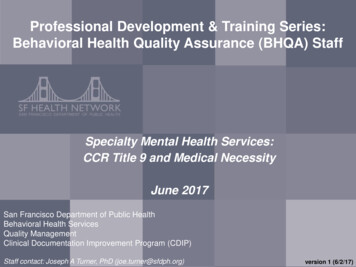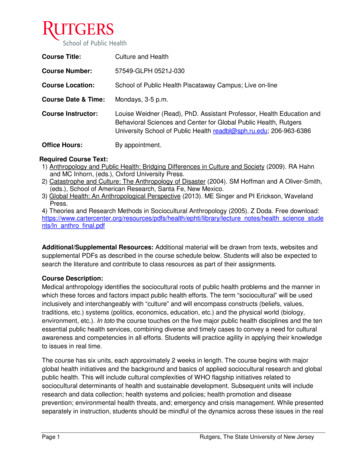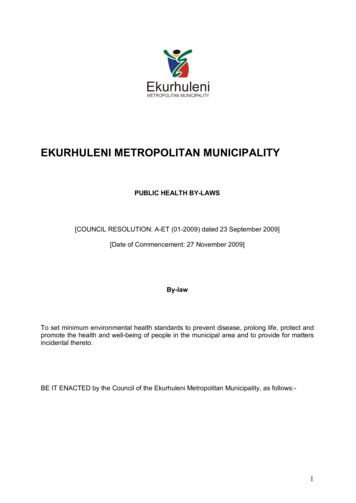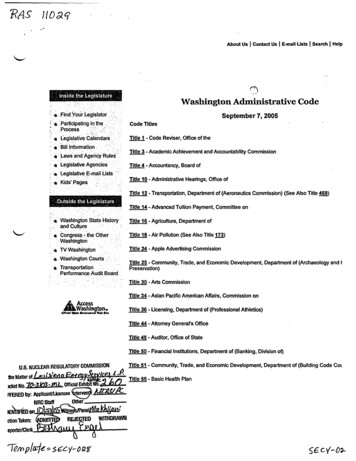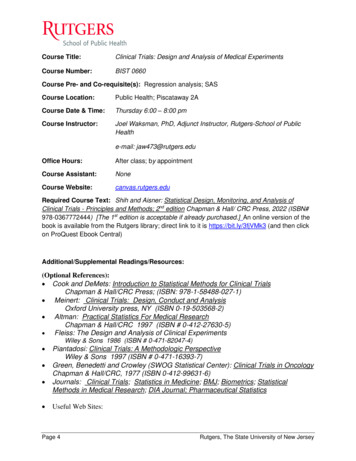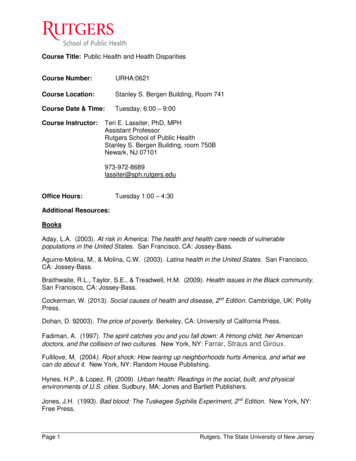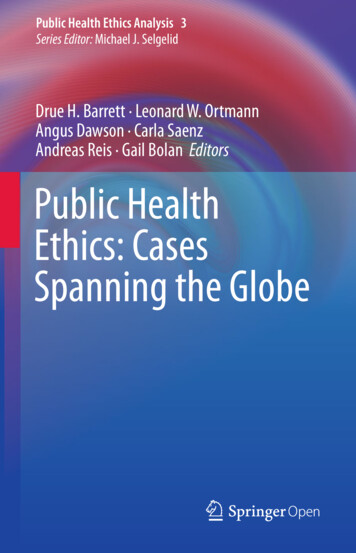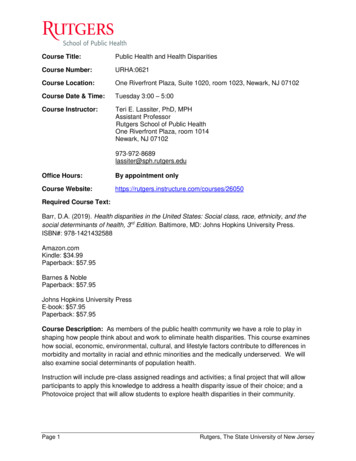
Transcription
Course Title:Public Health and Health DisparitiesCourse Number:URHA:0621Course Location:One Riverfront Plaza, Suite 1020, room 1023, Newark, NJ 07102Course Date & Time:Tuesday 3:00 – 5:00Course Instructor:Teri E. Lassiter, PhD, MPHAssistant ProfessorRutgers School of Public HealthOne Riverfront Plaza, room 1014Newark, NJ 07102973-972-8689lassiter@sph.rutgers.eduOffice Hours:By appointment onlyCourse 050Required Course Text:Barr, D.A. (2019). Health disparities in the United States: Social class, race, ethnicity, and thesocial determinants of health, 3rd Edition. Baltimore, MD: Johns Hopkins University Press.ISBN#: 978-1421432588Amazon.comKindle: 34.99Paperback: 57.95Barnes & NoblePaperback: 57.95Johns Hopkins University PressE-book: 57.95Paperback: 57.95Course Description: As members of the public health community we have a role to play inshaping how people think about and work to eliminate health disparities. This course examineshow social, economic, environmental, cultural, and lifestyle factors contribute to differences inmorbidity and mortality in racial and ethnic minorities and the medically underserved. We willalso examine social determinants of population health.Instruction will include pre-class assigned readings and activities; a final project that will allowparticipants to apply this knowledge to address a health disparity issue of their choice; and aPhotovoice project that will allow students to explore health disparities in their community.Page 1Rutgers, The State University of New Jersey
Selected Concentration Competencies Addressed:Each Concentration identifies competencies for each degree offered. The competenciesaddressed in this course for the MPH in Urban-Global Public Health include:1. Analyze the role of individual, biological, social, economic, political, and environmentalfactors that influence the health status of urban populations;2. Use relevant sources (including public health literature and qualitative and quantitative data)to identify the health status and disparities in urban populations and communities;3. Examine the characteristics, unique health challenges, and opportunities of urbanpopulations and communities.4. Apply methods to develop and assess programs and strategies that protect or endanger thehealth and well-being of urban populationsPlease visit the Concentration webpages on the School of Public Health’s website atsph.rutgers.edu for additional competencies addressed by this course for other degrees andconcentrations.Course Objectives: By the completion of this course, students will be able to:a. To understand the historical development of systems of racial classification and their use inscientific inquiry and public policy.b. Articulate complex relationships between race, socioeconomic status, psychosocial andcultural factors and how these relationships underlie health disparities.c. Assess the impact of health care access and quality on health status and health disparities.d. To examine potential strategies for better understanding health disparities and workingtoward health equity.Course Requirements and Grading:AssignmentsWeekly ReadingsWeekly reading assignments are listed on the course syllabus. Links have been provided for allarticles, reports, and websites that are required for the weekly reading assignments. If youdiscover that one of the links is not working, please notify me immediately. The links werecurrent as of August 31, 2019.Consider the following as you complete the readings so that you are prepared to discuss themin class:1.2.3.4.5.Page 2What are the main questions the author is posing?What is the methodology?What are the main conclusions?Do you agree or disagree with the conclusions?What additional questions does the article raise?Rutgers, The State University of New Jersey
All readings are mandatory and must be read prior to each class. Lectures are not meantto substitute the reading materials.All written assignments for this class are to be submitted electronically through thecourse page in Canvas using Microsoft Word and following APA formatting. Allreferences and in text citations must use APA format only (pay particular attention tohow to cite internet sources). Correct use of APA formatting is part of your grade forwritten assignments. The assignments should have a one inch -margin on all sides,double spaced, and use 11 point font size. Recommended fonts are Arial, Calibri orTimes New Roman.LATE ASSIGNMENTS WILL NOT BE ACCEPTED.Semester ProjectCommunity Health Needs Assessment – Health Care Foundation of the Oranges, Inc. –Group AssignmentFor this assignment you will work in teams to conduct a portion of a Community Health NeedsAssessment (CHNA) for the Health Care Foundation of the Oranges, Inc., an independent nonprofit, community-based healthcare foundation.The Health Care Foundation of the Oranges, Inc., formerly the Foundation for East OrangeGeneral Hospital, was formed in 2016 as a result of the sale of East Orange General HospitalInc. to a for-profit entity. Through their partnerships, they seek to provide a multitude ofresources that will improve the overall emotional, mental and physical health of individuals.Their partners include local government agencies, faith-based, and community-basedorganizations. It is their vision that their shared initiatives will have a beneficial and lifelongimpact on the individuals in the communities that they serve.Their mission is to promote healthcare awareness, education and funding for healthcareinitiatives within their service area. It is their goal to improve the overall health of individuals inthe communities that they serve.The Health Care Foundation of the Oranges serves and supports healthy initiatives in EastOrange, Orange, Irvington, along with the South & West Wards of Newark.The Foundation, based upon local, county and national data identified via the 2016 CHNAconducted by East Orange General Hospital; annual (2016-2019) county health indicator dataprovided by County Health Rankings & Roadmaps (A Robert Wood Johnson FoundationProgram) and recommendations from the 2014 Commission to ‘Build a Healthier America haveintentionally guided the Foundation to request research and exploration of the following areas ofthe social determinants of health (SDOH): Page 3Economic StabilityEducationSocial and Community ContextHealth and Health CareNeighborhoods and the Built EnvironmentRutgers, The State University of New Jersey
A community health needs assessment (CHNA) is vital to identifying the health concerns ofcommunities, to learn about the factors that influence their health and the assets, resources,and challenges that impact those factors. For your Semester Project, you will be conducting aliterature review on your SDOH and researching what resources are available in the state,county and city of interest. The “needs” have been identified by the Foundation, you areresponsible for finding the “answers” to address the needs.For each SDOH, specific topic areas have been selected by the Foundation for this project.Groups and topics will be assigned on the Tuesday, September 3, 2019, the first night of class.Assignment 1:Conduct a literature review focusing on the SDOH and health disparities associated with theSDOH and the effects it has on the city targeted for your project.Assignment 2:Conduct an internet search to identify agencies (federal, state, county and local), communitybased organizations and resources that provide services associated with your SDOH.From you findings, develop a resource guide that the Foundation can use with its stakeholdersto address the SDOH and disparities in the communities that they serve.Assignment 3:Create an executive summary of your needs assessment. The summary should include anoverview of your city, including basic demographic information, relevant issues associated withyour SDOH and disparities, and your recommendations for future work.Assignment 4:PowerPoint presentation.Examples of Community Resource Guides The New Jersey Institute for Social Justice Presents: The Community Resource ark Community Resource Guide.pdf?1502899437 The Newark Public School’s Community Resource resourcedirectory.pdf East Harlem Community Resource /dc/east-harlem-resource-guide.pdfStrategies for Reducing Health pdfs/su6501.pdfPage 4Rutgers, The State University of New Jersey
Photovoice ProjectFor this assignment, you will need to use a camera; the camera on your phone will due.The purpose of this assignment is for you to gain a better understanding of health disparities inthe communities where you live, work and/or socialize.1. You are to take no more than five (5) pictures depicting a health disparity that you see in thecourse of your everyday life. The pictures can focus on one or several themes that you feelimpact the area where they are taken. Once you have taken the pictures, write a three (3)page reflective paper about what you have seen, please include the pictures in your paper.a.b.c.d.How does what you have seen affect the area where the pictures were taken?What did you learn from taking the pictures?How did you feel while you were in the area?If you were to advocate to change the problem seen in your pictures, how would youcommunicate this to local officials?MAKE SURE THAT YOU ARE IN A SPACE PLACE WHEN TAKING THESE PICTURES.DO NOT ENTER DANGEROUS PLACES/SITUATIONS. BEFORE YOU CHOOSE A PLACETO TAKE YOUR PICTURES ASK YOURSELF IF THE LOCATION POSES A RISK TO YOUAND IS IT A DNAGEROUS LOCATION.DO NOT TAKE PICTURES OF PEOPLE’S FACES! YOU DO NOT WANT TO INVADEANYONE’S PRIVACY!DO NOT BECOME INVOLVED WITH ANY LAW ENFORCEMENT OR ILLEGAL ACTIVITIESWHILE TAKING THESE PICTURES.TAKE THE PICTURES DURING DAYLIGHT HOURS ONLY!2. Each student will present a picture from their Photovoice project. Presentations will be 5minutes. You are expected to explain why you selected the picture and its relationship tohealth disparities.Please submit your picture to me no later than Monday, December 16, 2019.Journal ClubThe purpose of the journal club is to develop your ability to lead a discussion, to critique theliterature, and to learn how to communicate ideas. This will take place during last 30 minutes ofeach class will be devoted to a student-led journal club. During this time, the class willcollectively examine the contents and implications of one or more of the assigned readings.Each student will be responsible for facilitating or co-facilitating a journal club. You are to reviewthe syllabus and select the week that you want to facilitate no later than the second class.Page 5Rutgers, The State University of New Jersey
You will need to identify an article associated with topic of the week you have selected tofacilitate. You will be responsible for disseminating the article to the professor and the membersof the class the week prior to your Journal Club. You are expected to provide a brief overview ofthe article and then lead the class discussion. You are responsible for providing the class with abrief summary of the article, focusing on the main concepts and ideas, as well as providing acritical analysis.Prior to class, you are to provide your classmates and the professor with at least three (3)questions that will be used to guide the discussion. The questions are to be submitted using theCanvas email.On-Line 30On-line 30 assignments are listed on the syllabus.Grading1. Semester Projecta. Assignment 1b. Assignment 2c. Assignment 3d. Assignment 42. Photovoice3. Journal Club4. Class ParticipationTotal20 pts.20 pts.25 pts10 pts.10 pts.10 pts.5 pts.100 pts.Links to Course Competencies and ObjectivesCompetency1Course Objectives(s)b, cLessons2, 3, 102b, c, d4, 5, 6, 7, 8, 934b, cc, d4, 9, 1112Assessment(s)Journal Club, SemesterProject, Photovoice, Online 30Journal Club, SemesterProject, On-line 30Photovoice, On-line 30Semester ProjectGrading Policy94 –90 –87 –84 –80 –77 –70 – 70100 94 90 87 84 80 77Page 6AAB BBC CFRutgers, The State University of New Jersey
Course roduction toHealthDisparities/Determinantsof Health09/17/2019Race andEthnicityAssigned ReadingsWeek 1Overview of the Course and CourseRequirementsDiscuss semester projectsLeslie Eaddy, MPHBrielle Gray-ArmstrongHealth Care Foundation of the Oranges, Inc.Week 2Textbook:Barr, Chapter 1: Introduction to the Social Rootsof Health DisparitiesBarr, Chapter 2: What is “Health”? How shouldWe Define It? How Should We Measure It?Article:Byrd, W.M., & Clayton, L.A. (2003). Racial andethnic disparities in healthcare: A background andhistory. In National Research Council (Ed.),Unequal treatment: Confronting racial and ethnicdisparities in health care (pp. 455-527).Washington, DC: The National Academies Press.http://www.nap.edu/catalog/10260.html (clickon hyperlink choose “Download Free PDF,”select “Download PDF (Chapters)” and openthe assignment.Week 3Textbook:Barr, Chapter 5: Race, Ethnicity, & Health, pp.103-130.AssignmentsOnline 30Complete thereading assignmentsfor Week 2.Complete thereading assignmentsfor Week 3.Complete On-line 30assignment for week3.Complete thereading assignmentsfor Week 4.Complete On-line 30assignment for week4.Semester ProjectAssignment 1 due.Videos:For each of thesevideos, write a 250word reflectionpaper.Unnatural CausesEpisode 3: ecoming-americanEpisode 4: Week 409/24/2019Maternal ChildHealthPage 7Guest SpeakerIlise ZimmermanPresident and Chief Executive OfficerComplete thereading assignmentsfor Week 5.Unnatural CausesEpisode 2: When theBough BreaksRutgers, The State University of New Jersey
WeekAssigned ReadingsPartnership for Maternal and Child Health ofNorthern New JerseyAssignmentsComplete On-line 30assignment for week5.Online s-0Complete thereading assignmentsfor Week 6.Complete On-line 30assignment for week6.Video:After watching thefilm, write a 300word paperdiscussing theimpact ofsocioeconomicstatus on aperson’s health.Articles:Advocates for children of New Jersey. (2019).Newark kids count, /10/01/2019SocioeconomicStatusTaylor, J., Novoa, C., Hamm, K., & Phadke, S.(2019). Eliminating racial disparities in maternaland infant mortality: A comprehensive policyblueprint. Center for American isparities-maternal-infant-mortality/Week 5Textbook:Barr, Chapter 4 Understanding How Low SocialStatus Leads to Poor Health pp. 64-102Barr, Chapter 6 Race/Ethnicity, socioeconomicStatus, and Health: Which is more Important inAffecting Health Status? pp. 131-167.Unnatural CausesEpisode 1: InSickness and nd-wealth10/08/2019Place Matters:Neighborhoodsand HealthPage 8Week 6Articles:Kelling, G.L. & Wilson, J.Q. (1982). Brokenwindows. The Atlantic Monthly, 249(3), 1982/03/broken-windows/304465/Stewart, E.A., & Simons, R. L. (2010). Race,code of the street, and violent delinquency: Amultilevel investigation of neighborhood streetculture and individual norms of violence.Criminology, 48(2), /j.17459125.2010.00196.x/epdfBogard, K., Murry, V., & Alexander, C, eds.(2017). Perspectives on health equity and socialdeterminants of health. Washington, DC: NationalAcademy of Medicine.Complete thereading assignmentsfor Week 7.Film:After watching thefilm, write a 500word paperdiscussing thechallenges of foodinsecurity in theUnited States,focusing on wherepeople live.A Place at the TableModule 1Rutgers, The State University of New Jersey
Homelessness10/22/2019PopulationGroups:Children andAdolescents10/29/2019Populationgroups:LGBTQI Assigned ts-of-Health.pdfChapter 12: Urgent Dispatch: Calling onLeadership to Respond to Violence in BlackNeighborhoods as a Public Health Crisis, pp. 203218Week 7Readings:Wildeman, C. & Wang, E.A. (2017). Massincarceration, public health, and wideninginequality in the USA. Lancet, 389, i/S0140673617302593?token 149C8416846D9073442EF1E6BFEEAE605C5AFC61032B9FWeek 8TextbookBarr, Chapter 7 Children’s Health Disparities, pp.168-195Articles:Metzler, M., Merrick, M.T., Klevens, J., Ports,K.A., & Ford, D.C. (2017). Adverse childhoodexperiences and life opportunities: Shifting thenarrative. Children and Youth Services Review,72, cle/pii/S0190740916303449Trent, M., Dooley, D.G., & Douge, J. (2019). Theimpact of racism on child an adolescent health.Pediatrics, 144 (2), ontent/pediatrics/144/2/e20191765.full.pdfWilhelm, A.K. & Allen, M.L. (2018). Socialdeterminants of health for racially and ethnicallydiverse adolescents. In L. Barkley, M.V. Svetaz &V.L. Chulani (Eds.), Promoting health equityamong racially and ethnically diverse adolescents(pp. 13-28).AssignmentsOnline 30Complete thereading assignmentsfor Week 8.Semester ProjectAssignment 2 due.Complete thereading assignmentsfor Week 978-3-319-97205-3.pdfWeek 9Guest SpeakerKristen Krause, MPHDoctoral Research Assistant at Center for Health,Identity, Behavior and PreventionRutgers School of Public HealthTOPIC: LGBTQ Health DisparitiesArticle:Page 9Rutgers, The State University of New Jersey
Week11/05/2019CancerDisparities11/12/2019Equity &EqualityPage 10Assigned ReadingsMollon, L. (2012). The forgotten minorities: Healthdisparities of the Lesbian, Gay, Bisexual, andTransgendered communities. Journal of HealthCare for the Poor and Underserved, 23, 1-6.doi:10.1353/hpu.2012.0009Week 10Guest SpeakersAnita Kinney, PhD, RNDirector of the Center of Cancer Health DisparitiesRutgers School of Public HealthAssociate Director of Cancer Health Equity andEngagementRutgers Cancer InstituteTOPIC: Cancer Disparities in New JerseyRita M. Musanti, PhD, ANP-BC, AOCNPRutgers Cancer Institute of New JerseyTOPIC: Cancer GenomicsWeek 11Textbook:Barr, Chapter 8 All Things Being Equal, DoesRace/Ethnicity Affect How Physicians TreatPatients?, pp. 196-229Chapter 9 Why Does Race/Ethnicity Affect theWay Physicians Treat Patients?, pp. 230-260Articles:Braveman, P. (2014). What are health disparitiesand health equity? We need to be clear. PublicHealth Reports, Supp 2, 0333549141291S203Woolf, S.H. (2017). Progress in achieving healthequity requires attention to root causes. HealthAffairs, 36(6), 377/hlthaff.2017.0197AssignmentsOnline 30Complete thereading assignmentsfor Week 11.Complete On-line 30assignment for week11.Complete thereading assignmentsfor Week 12.Semester ProjectAssignment 3 due.VideoWatch the videoand submit a 500word paperreflecting on healthequity.The Role of theSocial Determinantsof Health inPromoting HealthEquityPresented by theNational Health Carefor the HomelessCouncil and theNational Center forMedical Education,Development andResearchMonday, August 20,2018 11 a.m-12p.m. CTThe impact of factorssuch as housing,socioeconomicstatus, education,social support, andsafety have been welldocumented as keyinfluencers of apatient’s health andresponse toRutgers, The State University of New Jersey
WeekAssigned ReadingsAssignmentsOnline 30treatment. In fact,they may have moreinfluence over healthoutcomes thanaccess to medicalservices alone.This webinar willprovide an overviewof the SocialDeterminants ofHealth (SDOH) anddescribe how thesedeterminantspromote healthequity. Therelationship betweenSDOH and implicitbias will be explored.Participants will alsolearn how culturalhumility may be usedto addressunconscious biases.https://www.youtube.com/watch?v RdN9ZyWbqkk11/19/2019ReducingHealthDisparitiesWeek 12Textbook:Barr, Chapter 11 What Should We Do to ReduceHealth Disparities?, pp. 279-307.11/26/2019Week 13No class – Thursday classes meet12/03/2019Week 14Group Presentations12/10/2019Week 15Group Presentations12/17/2019Week 16Photovoice PresentationsPage 11Semester ProjectAssignment 4 due.Semester ProjectAssignment 4 due.PhotovoiceAssignment due.Rutgers, The State University of New Jersey
Learning Management System: Canvas will be used extensively throughout the semester for coursesyllabus, assignments, announcements, communication and/or other course-related activities. It is thestudent’s responsibility to familiarize themselves with Canvas and check it regularly. If you havedifficulties accessing Canvas, please inform the instructor and Canvas Support(help@canvas.rutgers.edu). Canvas is accessible at canvas.rutgers.edu.School of Public Health Honor Code: The School of Public Health Honor Code is found in the SchoolCatalog (sph.rutgers.edu/academics/catalog.html). Each student bears a fundamental responsibility formaintaining academic integrity and intellectual honesty in his or her graduate work. For example, allstudents are expected to observe the generally accepted principles of scholarly work, to submit their ownrather than another’s work, to refrain from falsifying data, and to refrain from receiving and/or giving aidon examinations or other assigned work requiring independent effort. In submitting written material, thewriter takes full responsibility for the work as a whole and implies that, except as properly noted by use ofquotation marks, footnotes, etc., both the ideas and the works used are his or her own. In addition tomaintaining personal academic integrity, each student is expected to contribute to the academic integrityof the School community by not facilitating inappropriate use of her/his own work by others and byreporting acts of academic dishonesty by others to an appropriate school authority. It should be clearlyunderstood that plagiarism, cheating, or other forms of academic dishonesty will not be tolerated and canlead to sanctions up to and including separation from the Rutgers School of Public Health.Students with Disabilities: Rutgers University welcomes students with disabilities into all of theUniversity's educational programs. In order to receive consideration for reasonable accommodations, astudent must apply for Services by first completing a Registration Form with the Rutgers Office ofDisability Services (ODS) at ods.rutgers.edu. The student will also be required to participate in an ODSintake interview and provide documentation. If reasonable accommodations are granted, ODS will provideyou with a Letter of Accommodations which should be shared with your instructors as early in yourcourses as possible.Commitment to Safe Learning Environment: The Rutgers School of Public Health is committed tohelping create a safe learning environment for all students and for the School as a whole. Freeexpression in an academic community is essential to the mission of providing the highest caliber ofeducation possible. The School encourages civil discourse, reasoned thought, sustained discussion, andconstructive engagement. Provocative ideas respectfully presented are an expected result. Anenlightened academic community, however, connects freedom with responsibility. The Schoolencourages all students to disclose any situations where you may feel unsafe, discriminated against, orharassed. Harassment or discrimination of any kind will be not tolerated and violations may lead todisciplinary actions.Reporting Discrimination or Harassment: If you experience any form of gender or sex-baseddiscrimination or harassment, including sexual assault, sexual harassment, relationship violence, orstalking, know that help and support are available. You may report such incidents to the RBHS Title IXOffice or to the School of Public Health’s Office of Student Affairs. Rutgers University has staff memberstrained to support survivors in navigating campus life, accessing health and counseling services,providing academic and housing accommodations, and more. If you experience any other form ofdiscrimination or harassment, including racial, ethnic, religious, political, or academic, please report anysuch incidents to the School’s Office of Student Affairs. The School strongly encourages all students toreport any incidents of discrimination or harassment to the School. Please be aware that all Rutgersemployees (other than those designated as confidential resources such as advocates, counselors, clergyand healthcare providers as listed in Appendix A to Policy 10.3.12) are required to report informationabout such discrimination and harassment to the School and potentially the University. For example, ifyou tell a faculty or staff member about a situation of sexual harassment or sexual violence, or otherrelated misconduct, the faculty or staff member must share that information with the RBHS Title IXCoordinator. If you wish to speak to a confidential employee who does not have this reportingresponsibility, you can find a list of resources in Appendix A to University Policy 10.3.12. For morePage 12Rutgers, The State University of New Jersey
information about your options at Rutgers, please visit Rutgers Violence Prevention and VictimAssistance.Graduate Student Computer Policy: Students are required to possess a personal laptop, no older thanapproximately two years, that must meet minimum requirements which may be found online tmlPolicy Concerning Use of Recording Devices and Other Electronic Communications Systems:When personally owned communication/recording devices are used by students to record lectures and/orclassroom lessons, such use must be authorized by the faculty member or instructor who must give eitheroral or written permission prior to the start of the semester and identify restrictions, if any, on the use ofmobile communications or recording devices.Policy Concerning Use of Turnitin: Students agree that by taking this course all required papers maybe subject to submission for textual similarity review to Turnitin.com (directly or via learning managementsystem, i.e. Canvas) for the detection of plagiarism. All submitted papers will be included as sourcedocuments in the Turnitin.com reference database solely for the purpose of detecting plagiarism of suchpapers. Use of the Turnitin.com service is subject to the Usage Policy posted on the Turnitin.com site.Students who do not agree should contact the course instructor immediately.Withdrawal/Refund Schedule: Students who stop attending their course(s) without submitting acompleted Add/Drop Course form will receive a failing grade. Furthermore, students dropping to zerocredits for the semester are considered withdrawn and must submit a completed Leave of Absence formfrom the School of Public Health’s Office of Student Affairs. The School of Public Health refunds tuitiononly. Administrative and technology fees are non-refundable. You may find the Withdrawal/RefundSchedule on the School of Public Health website lPage 13Rutgers, The State University of New Jersey
Course Number: URHA:0621 Course Location: One Riverfront Plaza, Suite 1020, room 1023, Newark, NJ 07102 Course Date & Time: Tuesday 3:00 - 5:00 Course Instructor: Teri E. Lassiter, PhD, MPH Assistant Professor Rutgers School of Public Health One Riverfront Plaza, room 1014 Newark, NJ 07102 973-972-8689 lassiter@sph.rutgers.edu
